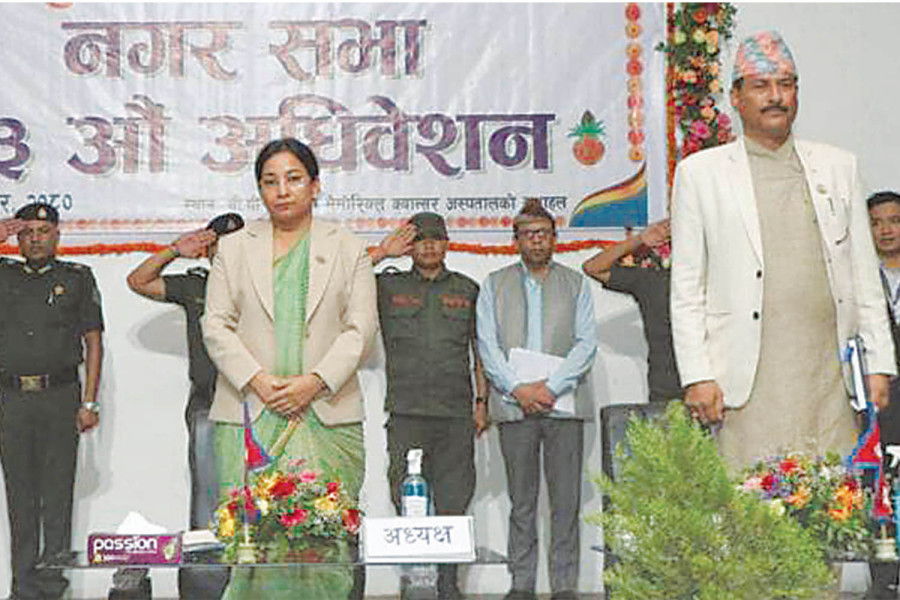Columns
Notes on a city’s success story
Bharatpur’s high citizen participation in development should be recognised as a commendable initiative.
Khim Lal Devkota
According to the Local Government Operation Act, local governments (LGs) must submit their budgets annually to their respective assemblies by Asadh 10, or the third week of June. Before submission to the assembly, the budget must receive approval from the executive and be passed by the end of Asadh, or the beginning of the third week of July. However, this year, 42 LGs did not submit their budgets within the specified time. As per the information on the Ministry of Federal Affairs and General Administration webpage, nine LGs had not submitted their budgets as of Tuesday, December 12.
The budget is designed for the people. Nearly six months have elapsed in the fiscal year, and, regrettably, these LGs have not yet passed their budgets, indicating a neglect of their responsibilities toward the people. Without approval from the assembly, the budget cannot be utilised. It is essential to withhold grants from the LGs that fail to address the local needs of citizens and redirect resources to those LGs that effectively meet the needs of the people and perform well.
The law mandates LGs to formulate and implement periodic, annual, sectoral, medium-term, and long-term development plans. There is also a provision that LGs’ plans should align with the policies, goals, objectives, deadlines, and processes of the federal and provincial governments’ planning and budgeting. Some LGs plans and programmes are such that the provincial and Federal governments should follow. Additionally, the experiences and achievements of certain LGs are worthy of imitation for other LGs levels.
In this context, I have been actively involved in multiple discussions and interactions with representatives from Bharatpur Metropolitan City. I have trained the representatives elected through the 2022 and 2017 elections on local planning, budgeting and various other issues. This article is based on the information acquired during these interactions and discussions and the facts and figures presented by the city, including the budget speech document for the fiscal year 2023-24. The anticipation is that the commendable practices implemented by the city will serve as a beneficial model for other LGs and relevant stakeholders.
Lessons from Bharatpur
Of the 753 LGs in Nepal, Bharatpur Metropolitan City ranks the third-largest in terms of population, with 369,268 residents. Comprising 29 wards, this city stands as the sole metropolitan city in Nepal, with Mayor Renu Dahal’s leadership in both the 2017 and 2022 elections.
When Dahal was elected in 2017, she brought a first budget of Rs3.50 billion. In the current FY 2023-24, the figure increased to Rs6.21 billion. As per the information provided by the revenue section, the actual internal revenue in her first year amounted to Rs49 crore (Rs490 million), and this revenue stood at Rs1.18 billion in the FY 2022-23 and is projected to reach Rs1.75 billion in FY 2023-24. Even considering this financial statement as the benchmark, the observed transformation represents a significant leap forward.
As per the policy and programme document of the current FY, the city, serving as the hub for medical and educational facilities, has completed 648 km of new black-topped roads and 460 km of gravel roads. Since the local elections in 2017, black-topped roads have extended to nearly every corner and district within this city, marking significant progress. The construction of foot tracks along the Narayani River has been completed in several areas, including Ward 1. This programme has substantially benefited citizens by constructing a park with a “Beach Concept” suitable for all age groups, concurrently increasing economic activity through tourism promotion and boosting the city's revenue.
As informed by Mayor Dahal, the construction of smart toilets in three locations, roads equipped with amenities such as bicycle lanes, city halls with modern facilities, smart street lighting, and the development of multipurpose buildings integrating commercial activities are some ongoing initiatives.
Citizens in this city have been actively engaging in its development. According to the information provided by Under Secretary Jagannath Aryal, public involvement in construction and development stands at an impressive 70 percent. In FY 2021-22, approximately Rs400 million in cash and labour contributions were raised. Such high levels of citizen participation in development should be recognised as commendable initiatives.
The city has constructed an 'Umbrella Street with View Point' at Ward 22, Patihani, along the banks of the Rapti River. Covering approximately 100 meters, this street includes a viewing platform overlooking the riverbank, an entrance, public restroom facilities, and a water fountain. Vibrant wall paintings depict the traditional costumes of the local Tharu community. According to Ward Chair Bishnu Mahato, hundreds of tourists visit this area daily. This development has significantly boosted businesses in the vicinity, including hotels, restaurants, and jungle safaris along the shore.
Bharatpur city has taken proactive measures to address health and social development concerns, particularly targeting vulnerable and marginalised groups like women, children, individuals with disabilities, and those affected by various hardships. Their initiatives span various facets, including complimentary ambulance services for expectant mothers, distributing bicycles to underprivileged female students, and operating insurance programs for daughters born in government health institutions. Notably, the city has provided 650 bicycles to date, making Bharatpur a place with a significant number of female bicycle users.
The city supports female health volunteers and families affected by conflict, offering cash rewards to volunteers and monthly economic aid to affected families. Through these efforts, 92 families receive Rs2,000 monthly. Additionally, Bharatpur Hospital implements a free OPD ticket subsidy, granting a 100 percent discount to women, senior citizens, and individuals with disabilities seeking health services. The city allocates an average of Rs6 million annually to facilitate this support.
Efforts in water provision include discounted tariffs for consumers using up to 7,000 litres monthly. These programs signify the city's commitment to social welfare, emphasising inclusive healthcare, financial aid, and essential services to uplift vulnerable communities.
According to Chitrasen Adhikari, Deputy Mayor, farmers have been benefiting from a 75 percent subsidy on soil testing and agricultural limestone. Additionally, they receive subsidies for agricultural seeds. The distribution of 89 pieces of equipment, including tractors, is also subsidised. Further, milk-producing farmers are granted a subsidy of Rs3 per litre, significantly assisting those engaged in milk production. To date, an estimated 12,000 farmers have collectively received 61 million rupees in support.
In discussions about the education sector, Narendra Kumar Rana, Chief Administrative Officer, highlights significant strides. Bharatpur Balmandir Autism Special School for children with autism disabilities and the Cerebral Palsy Resource Class for children with cerebral palsy have been established and are operational, prioritising the right to education for children with diverse conditions and disabilities.
Policy mandates allocating at least 10 percent of the budget to education by forming a ward education committee to uplift education quality at the ward level. Additionally, mobilising 140 young volunteers ensures adequate teaching staff in community schools, focusing on maintaining high-quality teaching standards.
The city has allocated a budget for painting all public schools within three years, aligning with the Nepal Government’s colour code standards to improve physical infrastructure and create a consistent, child-friendly environment. Furthermore, in collaboration with government schools, scholarships have been awarded to 274 class 11 students and 239 class 12 students, recognising inclusive merit.
The city has designated 2024 as the year to visit Bharatpur, featuring numerous programmes and initiatives. These include implementing the “one house and two trees” planting initiative, establishing park and playground programmes in multiple wards, school enhancements, and introducing learning and earning programmes at community schools. Bharatpur and many other LGs have undertaken commendable work, highlighting that they serve as the closest government entities to the people.




 9.12°C Kathmandu
9.12°C Kathmandu















